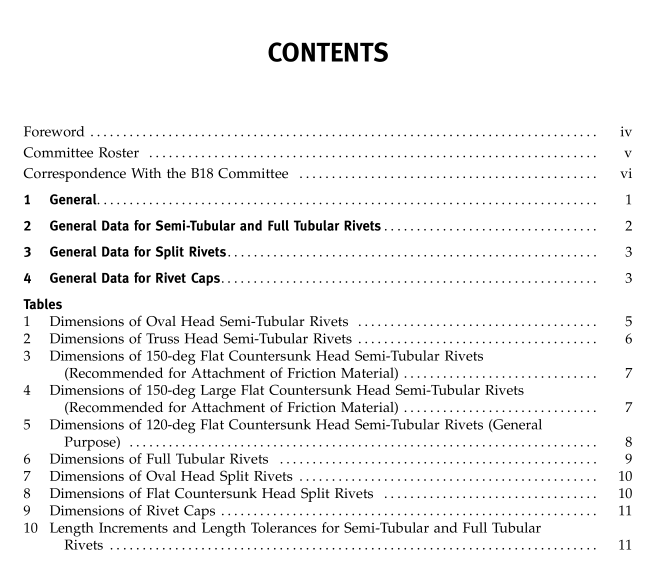ASME B18.7 pdf download

ASME B18.7 pdf download General Purpose Semi-Tubular Rivets, Full Tubular Rivets, Split Rivets, and End Caps
2 GENERAL DATA FOR SEMI-TUBULAR AND FULL TUBULAR RIVETS
2.1 Heads
2.1.1 Because the heads of these rivets are not machined or trimmed, the circumference may be some- what irregular and edges may be rounded or flat.
2.1.2 The bearing surface of oval and truss head rivets shall be perpendicular to the axis of the rivet shank within 2 deg.
2.1.3 The rivet head and the rivet shank shall be concentric within 11% of the nominal shank diameter on the basis of full indicator movement (FIM).
2.2 Underhead Fillets Oval and truss head rivets shall be furnished with a definite filletunderthe head; however, the radius offillet shall not exceed the values specified in the dimensional tables.
2.3 Length
2.3.1 Measurement. The length of oval and truss head rivets shall be measured, parallel to the axis of rivet, from the underside of the head to the extreme end. The length of flat countersunk head rivets shall be measured, parallel to the axis of rivet, from the juncture of the conical underside of head with rivet shank to the extreme end, except for the 120-deg flat countersunk head rivets in Table 5, on which the length shall be measured from the top of the head to the extreme end.
2.3.2 Length Increments. The minimum lengths and increments applicable to longer lengths shall be as specified in Table 10.
2.3.3 Tolerance on Length. The tolerance on length of rivets shall be as specified in Table 10. 2.4 Hole Depth 2.4.1 Hole depth shall be measured parallel to the axis of the rivet from the extreme end of the rivet to the intersection of the diameter of the hole with the contour at the bottom of the hole. The hole depth to the extreme point on the bottom contour of the hole shall not be greater than the shank length of the rivet.
2.4.2 The tolerance on hole depth shall be the same as the tolerance on length of the rivet.
2.5 Material Semi-tubular and full tubular rivets shall be made from low carbon steel (0.1% carbon or less) (UNS G10050), commercial yellow brass (UNS C26800), copper (UNS C14700), aluminum (UNS A95052), or other materials as agreed upon between the manufac- turer and the purchaser.
2.6 Finish Unless otherwise specified, rivets shall be supplied with a natural (as processed) finish, unplated or uncoated. Rivets may be furnished plain (bare metal) or with a protective coating (electrodeposited plating and/or chemical conversion coating) as specified by the user. All rivets shall be provided with a supplementary lubricant if necessary to meet the stated performance requirements without galling. The lubricant shall be clean and dry to the touch, shall not be irritating to normal skin, nor emit an unpleasant odor during rivet assembly. The performance of rivets that are furnished with a protective coating shall not deteriorate when the rivets are stored indoors for a period of 6 months. In cases where rivets are given a protective coating or are cleaned following delivery to the purchaser, the rivet producer shall not be held responsible for failure of the rivet to meet dimensional, mechanical, or performance requirements traceable to plating, coating, or cleaning practice. Lubrication (e.g., waxing) may improve the setting of the rivet. NOTE: Nickel and chromium finishes are very hard and, there- fore, will have a tendency to flake off the end of the rivet when it is set by the user.
2.7 Workmanship The rivets shall be free from all burrs, seams, or other imperfections that might impair their usability. Rivets are not machined or trimmed, and unevenness of the tubular end shall not be such that the usability of the rivet shall be impaired, when clinched with properly aligned, appropriate setting tools.
2.8 Designation
2.8.1 Semi-tubular and full tubular rivets shall be designated bythe following data inthe sequence shown:









